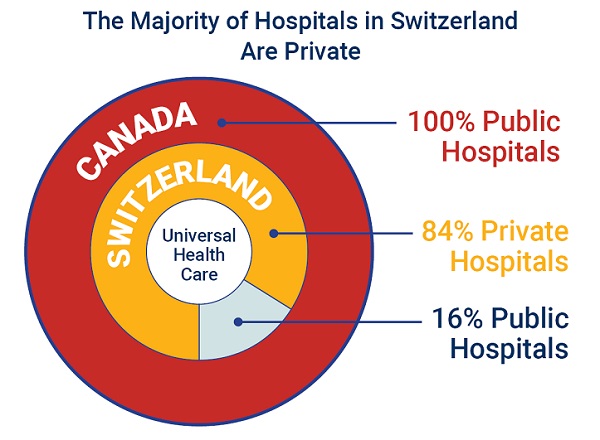Fraser Institute
Canada can solve its productivity ‘emergency’—we just need politicians on board

From the Fraser Institute
By Jake Fuss
Policymakers are slowly acknowledging the problem, but their proposed solutions are troubling.
According to Carolyn Rogers, senior deputy governor of the Bank of Canada, it’s time to “break the glass” and respond to Canada’s productivity “emergency.” Unfortunately, the country is unlikely to solve this issue any time soon as politicians are doubling down on the policy status quo rather than making sorely needed reforms.
Worker productivity—the level of output in the economy per hour worked—is a crucial indicator of a country’s underlying economic performance. When productivity increases, we not only increase our output and efficiency, but worker wages typically rise as well.
According to Statistics Canada, the country’s productivity dropped for six consecutive quarters before eking out a small gain in the final quarter of 2023. Rogers is right, this is an emergency, and it’s unsurprising that living standards for Canadians are falling alongside our productivity. Since the second quarter of 2022 (when it peaked post-COVID), inflation-adjusted per-person GDP (a common indicator of living standards) declined from $60,178 to $58,111 by the end of 2023—and declined during five of those six quarters, now sitting below where it was at the end of 2014.
Policymakers are slowly acknowledging the problem, but their proposed solutions are troubling. Federal Finance Minister Chrystia Freeland, for instance, recently emphasized the importance of making “investments in productivity and growth.” Yet, the federal government increased taxes on capital gains in its recent budget, which will disincentivize investment in Canada. Usually, when a politician says the word “investment” this is a fancy way of saying we need more government spending.
And in fact, more government spending appears to be the popular solution to every problem for most governments in Canada these days. Canadian premiers and the prime minister already support this approach in health care even though it’s been tried for decades. The result? In 2023, the longest wait times for health care on record despite having the most expensive system (as a share of GDP) among high-income universal health-care countries.
And now, these same policymakers are advocating for the same approach to boost productivity—that is, throw taxpayer money at the problem and hope it will somehow go away.
But there’s hope—governments have other options. For starters, governments from coast to coast could eliminate interprovincial trade barriers, which limit productivity improvements by (among other things) shielding inefficient local businesses from competition from businesses in other provinces. Governments also effectively prohibit the entry of foreign-owned competitors in crucial industries such as telecommunications and air travel. There’s less incentive for Canadian firms to innovate or improve when there’s no threat to shake things up.
Moreover, if governments reduced regulatory red tape and subsequent compliance costs, firms could allocate more resources towards training their workers, investing in equipment, and producing new and better products. And if governments reduced tax rates on families and businesses, they could make Canada more attractive to productive businesses, high-skilled workers and investors. Our current relatively high tax rates on capital gains, personal income and businesses income discourage capital investment and scare away the best and brightest scientists, engineers, doctors and entrepreneurs.
The Trudeau government, and other governments in Canada, seemingly want to spend their way out of our productivity emergency. While some level of government spending can help improve productivity, continued spending increases reallocate resources from the private sector to the government sector, which is by nature less productive. Governments should impose credible restraints (i.e. fiscal rules) on the growth of government spending to prevent this crowding out of private-sector investment.
There are plenty of ways Canada can boost productivity. We just need policymakers to be on board.
Author:
Fraser Institute
Long waits for health care hit Canadians in their pocketbooks

From the Fraser Institute
Canadians continue to endure long wait times for health care. And while waiting for care can obviously be detrimental to your health and wellbeing, it can also hurt your pocketbook.
In 2024, the latest year of available data, the median wait—from referral by a family doctor to treatment by a specialist—was 30 weeks (including 15 weeks waiting for treatment after seeing a specialist). And last year, an estimated 1.5 million Canadians were waiting for care.
It’s no wonder Canadians are frustrated with the current state of health care.
Again, long waits for care adversely impact patients in many different ways including physical pain, psychological distress and worsened treatment outcomes as lengthy waits can make the treatment of some problems more difficult. There’s also a less-talked about consequence—the impact of health-care waits on the ability of patients to participate in day-to-day life, work and earn a living.
According to a recent study published by the Fraser Institute, wait times for non-emergency surgery cost Canadian patients $5.2 billion in lost wages in 2024. That’s about $3,300 for each of the 1.5 million patients waiting for care. Crucially, this estimate only considers time at work. After also accounting for free time outside of work, the cost increases to $15.9 billion or more than $10,200 per person.
Of course, some advocates of the health-care status quo argue that long waits for care remain a necessary trade-off to ensure all Canadians receive universal health-care coverage. But the experience of many high-income countries with universal health care shows the opposite.
Despite Canada ranking among the highest spenders (4th of 31 countries) on health care (as a percentage of its economy) among other developed countries with universal health care, we consistently rank among the bottom for the number of doctors, hospital beds, MRIs and CT scanners. Canada also has one of the worst records on access to timely health care.
So what do these other countries do differently than Canada? In short, they embrace the private sector as a partner in providing universal care.
Australia, for instance, spends less on health care (again, as a percentage of its economy) than Canada, yet the percentage of patients in Australia (33.1 per cent) who report waiting more than two months for non-emergency surgery was much higher in Canada (58.3 per cent). Unlike in Canada, Australian patients can choose to receive non-emergency surgery in either a private or public hospital. In 2021/22, 58.6 per cent of non-emergency surgeries in Australia were performed in private hospitals.
But we don’t need to look abroad for evidence that the private sector can help reduce wait times by delivering publicly-funded care. From 2010 to 2014, the Saskatchewan government, among other policies, contracted out publicly-funded surgeries to private clinics and lowered the province’s median wait time from one of the longest in the country (26.5 weeks in 2010) to one of the shortest (14.2 weeks in 2014). The initiative also reduced the average cost of procedures by 26 per cent.
Canadians are waiting longer than ever for health care, and the economic costs of these waits have never been higher. Until policymakers have the courage to enact genuine reform, based in part on more successful universal health-care systems, this status quo will continue to cost Canadian patients.
Business
84% of Swiss hospitals and 60% of hospitalizations are in private facilities, and they face much lower wait times

From the Fraser Institute
If Canada reformed to emulate Switzerland’s approach to universal health care, including its much greater use of private sector involvement, the country would deliver far better results to patients and reduce wait times, finds a new study published today by the Fraser Institute, an independent, non-partisan Canadian policy think-tank.
“The bane of Canadian health care is lack of access to timely care, so it’s critical to look to countries like Switzerland with more successful universal health care,” said Yanick Labrie, senior fellow at the Fraser Institute and author of Integrating Private Health Care Into Canada’s Public System: What We Can Learn from Switzerland. The study highlights how Switzerland successfully integrates the private sector into their universal health-care system, which consistently outperforms Canada on most health-care metrics, including wait times.
For example, in 2022, the percentage of patients who waited less than two months for a specialist appointment was 85.3 per cent in Switzerland compared to just 48.3 per cent in Canada.
In Switzerland, 84.2 per cent of all hospitals are private (either for-profit or not-for profit) institutions, and the country’s private hospitals provide 60.2 per cent of all hospitalizations, 60.9 per cent of all births, and 67.1 per cent of all operating rooms.
Crucially, Swiss patients can obtain treatment at the hospital of their choice, whether located inside or outside their geographic location, and hospitals cannot discriminate against patients, based on the care required.
“Switzerland shows that a universal health-care system can reconcile efficiency and equity–all while being more accessible and responsive to patients’ needs and preferences,” Labrie said.
“Based on the success of the Swiss model, provinces can make these reforms now and help improve Canadian health care.”

Integrating Private Health Care into Canada’s Public System: What We Can Learn from Switzerland
- Access to timely care remains the Achilles’ heel of Canada’s health systems. To reduce wait times, some provinces have partnered with private clinics for publicly funded surgeries—a strategy that has proven effective, but continues to spark debate in Canada.
- This study explores how Switzerland successfully integrates private health care into a universal public system and considers what Canada can learn from this model.
- In Switzerland, universal coverage is delivered through a system of managed competition among 44 non-profit private insurers, while decentralized governance allows each of the 26 cantons to coordinate and oversee hospital services in ways that reflect local needs and priorities.
- Nearly two-thirds of Swiss hospitals are for-profit institutions; they provide roughly half of all hospitalizations, births, and hospital beds across the country.
- All hospitals are treated equally—regardless of legal status—and funded through the same activity-based model, implemented nationwide in 2012.
- The reform led to a significant increase in the number of cases treated without a corresponding rise in expenditures per case, suggesting improved efficiency, better use of resources, and expanded access to hospital care.
- The average length of hospital stay steadily decreased over time and now stands at 4.87 days in for-profit hospitals versus 5.53 days in public ones, indicating faster patient turnover and more streamlined care pathways.
- Hospital-acquired infection rates are significantly lower in private hospitals (2.7%) than in public hospitals (6.2%), a key indicator of care quality.
- Case-mix severity is as high or higher in private hospitals, countering the notion that they only take on simpler or less risky cases.
- Patient satisfaction is slightly higher in private hospitals (4.28/5) than in public ones (4.17/5), reflecting strong user experience across multiple dimensions.
- Canada could benefit from regulated competition between public and private providers and activity-based funding, without breaching the Canada Health Act.

-

 conflict1 day ago
conflict1 day agoIran nuclear talks were ‘coordinated deception’ between US and Israel: report
-

 illegal immigration2 days ago
illegal immigration2 days agoLA protests continue as judge pulls back CA National Guard ahead of ‘No Kings Day’
-

 conflict2 days ago
conflict2 days agoIsrael strikes Iran, targeting nuclear sites; U.S. not involved in attack
-

 Alberta1 day ago
Alberta1 day agoPunishing Alberta Oil Production: The Divisive Effect of Policies For Carney’s “Decarbonized Oil”
-

 International1 day ago
International1 day agoIsrael’s Decapitation Strike on Iran Reverberates Across Global Flashpoints
-

 Energy1 day ago
Energy1 day agoCanada is no energy superpower
-

 Business2 days ago
Business2 days agoTrump: ‘Changes are coming’ to aggressive immigration policy after business complaints
-

 Health1 day ago
Health1 day agoJust 3 Days Left to Win the Dream Home of a Lifetime!






